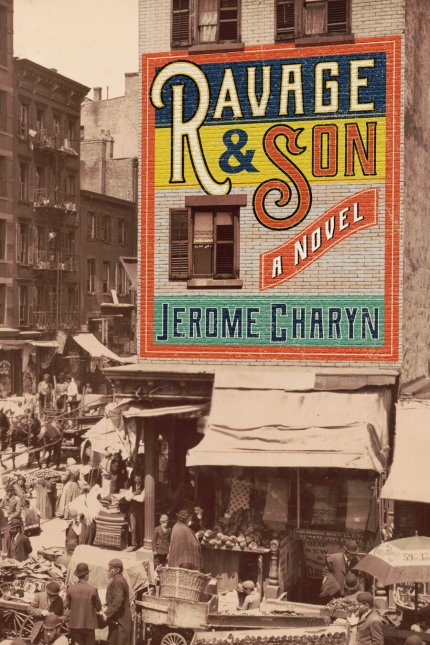Ravage & Son: A Novel
- By Jerome Charyn
- Bellevue Literary Press
- 288 pp.
- Reviewed by John P. Loonam
- September 11, 2023
Early-1900s Manhattan comes alive in this teeming, overstuffed tale.

Jerome Charyn is an institution. Having written dozens of books in a wide variety of genres, he is most famous for his chronicles of New York’s world of crime and police. In his new novel, Ravage & Son, he works with sex, violence, and even Woolworth’s to weave a complex and fantastical tale of revenge sprinkled with actual historical figures.
It’s 1883, and Lionel Ravage is the most important landlord on the Lower East Side of Manhattan, the Jewish quarter known at the Ghetto. He loves his cat, Chlöe, ignores his wife, Henrietta, and stalks the neighborhood with his silver wolf’s-head cane, bullying young women into sex by sometimes offering rent relief, other times by pretending to marry them.
When he meets Manya — a woman lavishly described as too beautiful to resist — his world of pleasure and profit is thrown into turmoil. He genuinely falls in love, leaves his family, and ignores his rent collection. He lives with Manya as if they’re man and wife (a fiction made easier because she believes the phony wedding he arranged). When representatives of the Kehilla (a secret society of wealthy, uptown German Jews who maintain order over the poor Russian Jews downtown) end the scandal by forcing Lionel to return to his wife, Manya is driven mad.
So much for the prelude.
In the main body of the narrative, it’s 1913. Benjamin Ravage, the son Manya was carrying when the Kehilla made Lionel dump her, has graduated from Harvard, where he was sent by Jacob Schiff (the real-life head of the banking firm Kuhn Loeb and financier of many of the nation’s largest railroads) to ease the Kehilla’s guilt over rendering him illegitimate. Ben becomes one of the Kehilla’s detectives, accompanied virtually everywhere by his partner, Monk Eastman (another historical figure, Eastman was a renowned gangster), a man so terrifying that Ben works their dangerous cases within a bubble of security as they try to clean up the Lower East Side.
Ben is soon charged with locating Leila Montague, the recently disappeared lover of Babette Meyer, daughter of a wealthy Kehilla member, whose life as a lesbianke has earned her the nickname “Bad Babette.” But Ben is really interested in exacting revenge on his father for driving his mother to an early death in the insane asylum. His work is closely followed by Abraham Cahan (the real-life editor of the Jewish Daily Forward, a Yiddish newspaper that, in 1913, had a circulation bigger than most English-language papers), who worries that the Kehilla is repressing the neighborhood’s drift toward socialism.
Charyn has an enormous imagination and creates a dizzying pile of characters and plot points. Along the way, we get little history lessons that touch upon Manhattan institutions like Lord & Taylor and Montefiore Hospital, not to mention Cahan, the Daily Forward, and the tension between German Jews and their impoverished Russian comrades. His skill is such that it’s difficult to separate the real-world figures and entities from the characters and places the author is inventing.
For example, one of the book’s major subplots involves Ben’s developing relationship with Clara Karp, an actress in the Yiddish theater that once thrived on the Lower East Side. (There’s still a sidewalk of fame on Second Avenue with stars’ names in the concrete.) Charyn’s Karp is famous for her portrayal of Hamlet and for her irresistible and unbridled sexuality — Kuhn, Cahan, and both Ravages fall under her spell at various times in the novel. There was a famous Yiddish actress in the early 1900s named Sophie Karp. Whether Charyn is including some factual portrait of her allure or has invented a new one is hard to tell.
Throughout, he paints his nostalgia in neon rather than sepia. The hyperbole used to describe Manya’s beauty and Clara’s sensuality is matched in Charyn’s depictions of violence and villains who prove heartless to a degree more suited to dark fairytales than mainstream fiction. Of course, such hyperbole may paint an accurate picture of Gotham at the time; perhaps people in this world simply eat, drink, fight, and have sex more often (and more energetically) than they do in my Brooklyn neighborhood.
In the end, Ravage & Son concentrates on Ben’s quest for vengeance against his father, leaving other narrative threads to fall by the wayside. Leila and Babette’s relationship slips past us, Cahan’s battles with his investors disappear, and Schiff’s financial stake in the Woolworth Building becomes a side note. That some of these side notes are more interesting than Ben’s story is the novel’s greatest tragedy.
John P. Loonam has a Ph.D. in American literature from the City University of New York and taught English in New York City public schools for over 35 years. He has published fiction in various journals and anthologies, and his short plays have been featured by the Mottola Theater Project several times. He is married and the father of two sons; the four have lived in Brooklyn long enough to be considered natives by anyone but his neighbors.

